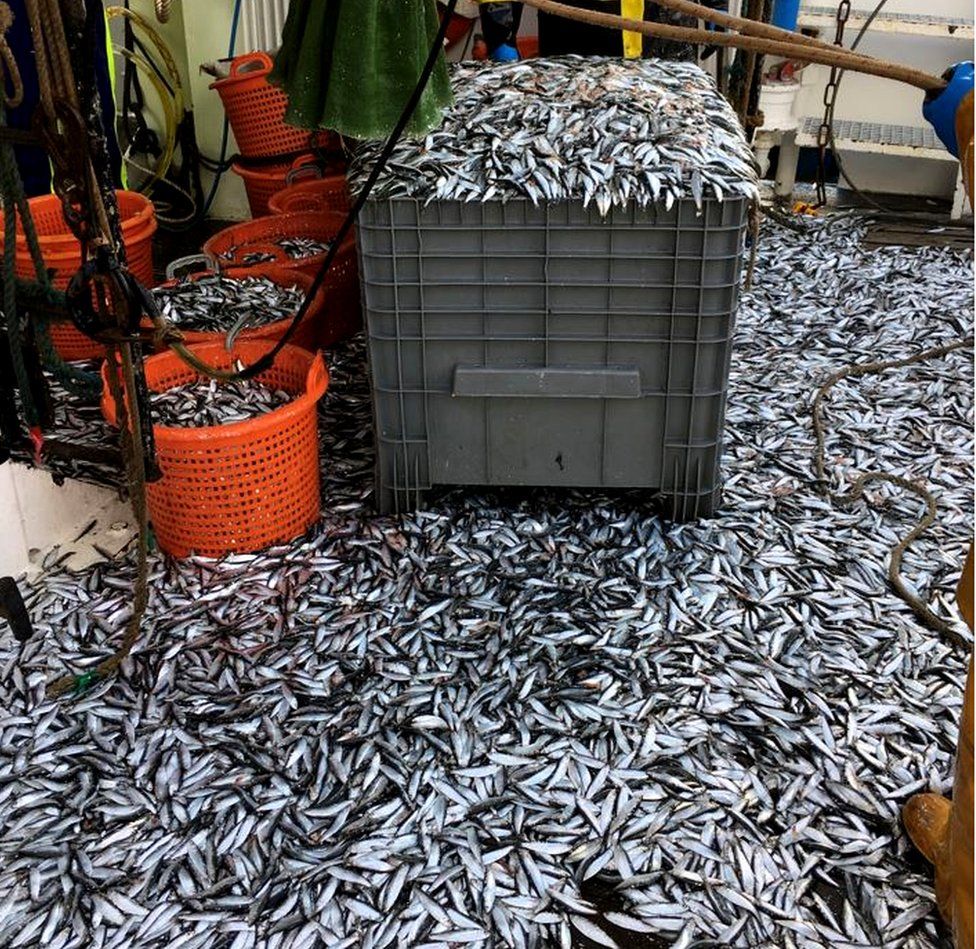Sprats return to the Clyde in huge numbers
- Published

The return of a small fish in large numbers could signal an improvement in the ecosystem of the Clyde.
The tiny fish live in open water and are a food source of other marine species.
Researchers at the University of Aberdeen have discovered massive schools of sprat in the Clyde sea, some more than 2km (1.2 miles) long and over 30m (100ft) deep.
The study found numbers had increased 100-fold since the late 1980s.
The Clyde was once a thriving marine ecosystem with large fisheries for herring and other species such as cod and haddock.
However, these fisheries disappeared, largely due to overexploitation in the latter part of the 20th Century, although a sustainable prawn fishery now operates.
Herring fishing, in particular, disappeared in the late 1990s.
This new Aberdeen-led study, published in the journal Current Biology, has shown that although herring are still present, the sprat population, a related species, is 100 times more numerous.
The last time herring and sprat were measured in the 1980s, the combined biomass - or weight - was a quarter of what it is now.
The authors worked with Marine Scotland Science on the vessel Alba na Mara, using scientific sonar equipment to detect the schools of fish.
They then used advanced sonar processing techniques to estimate the numbers of each species over three years from 2014 to 2016.
The total weight of sprat in 2016 was estimated at over 70,000 tonnes, equivalent to a population size of 23 billion individuals.
Dr Joshua Lawrence led the study which was funded by the Marine Alliance for Science and Technology Scotland (Masts).
He was surprised at the results.
'Centuries of exploitation'
He said: "The Clyde is famous for its herring, but although there has been virtually no fishing pressure on herring in over 20 years, it is the sprat population that has bounced back, not the herring.
"We can only speculate as to why this has happened - perhaps it is the warming seas, which may favour the sprat, or their more favourable reproduction strategy, as herring need particular gravel beds to spawn, whereas sprat do not.
"We also found a large concentrations of krill in the Clyde - a major food source for the fish and for other larger animals such as minke whales which are known to visit the area. So there are large populations at various levels of the marine food chain, which tells us that the Clyde's marine ecosystem is faring better than previously thought, despite centuries of overexploitation."
Prof Paul Fernandes, fisheries scientist at the University's School of Biological Sciences, said: "Sprat form a critical part of the marine food chain, and are vital for other larger fish such as cod and whiting, as well as other animals further up the food chain such as seabirds, whales, dolphins, and sharks.
"It is fantastic to see these parts of the food chain recover. This should, in time, lead to recovery of the populations of the larger animals that feed on them."
He said the findings now presented a dilemma to fisheries managers and the local seafaring community.
He said a sprat fishery could operate in the river, but a more sustainable and more lucrative opportunity could present itself through whale watching.
Anecdotal reports suggest more whales and dolphins appearing in the Clyde, and the university detected large numbers of porpoises in the area in a related study.
Prof Fernandes said: "As these whale populations themselves recover, they may find their way into these rich feeding grounds, much as they once did, and I am sure people would pay to see them, as they do in other parts of the world where marine ecosystems have recovered.
"The key will be to do this responsibly to ensure a long-term future for the Clyde's historic seafaring community."
Related Topics
- Published3 August 2021
- Published18 October 2020
- Published21 April 2018